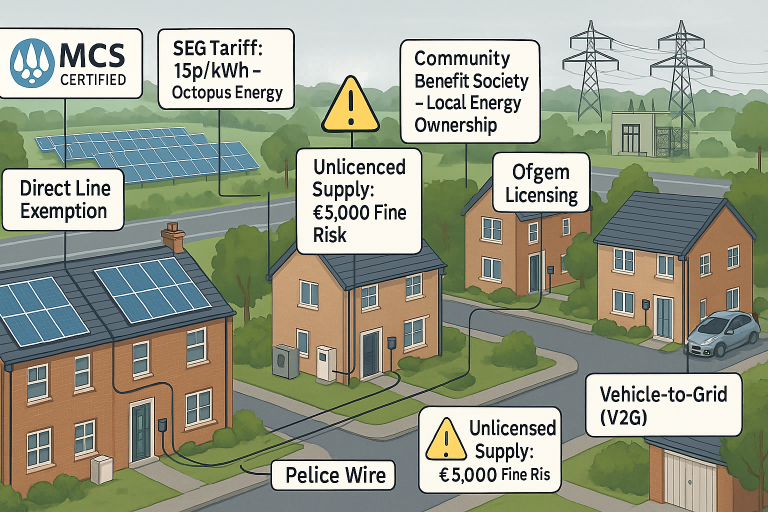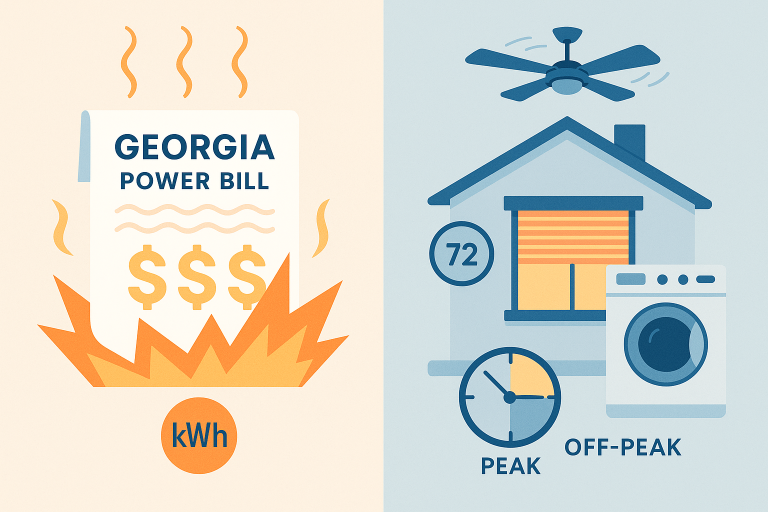Texas Electric Bills: Costs, Causes, and Cutting-Edge Solutions
When it comes to electric bills, Texans are paying more than they might expect—despite relatively affordable rates per kilowatt-hour. The average monthly electric bill in Texas ranges from $165 to $178, compared to the U.S. average of $144. At first glance, this seems paradoxical. After all, Texas has below-average electricity rates at 15.37¢ per kWh, versus the national average of 16.08¢ per kWh.
So why do Texans end up spending more?
The answer lies in how much energy they use—a staggering 1,146–1,499 kWh per month, which is over 34% higher than the national average of 855 kWh. This surge in consumption is driven by a unique combination of climate extremes, home size, and lifestyle patterns. Let’s dive deeper into the causes—and more importantly, the solutions.
Breaking Down the Costs: Home Size, Seasons, and Geography
Home Size Matters
Texans love space—and that love comes at a cost. Larger homes mean more square footage to cool, heat, and power. Here’s a breakdown of typical monthly energy use and costs based on home type:
| Home Type | Avg. Usage | Avg. Monthly Cost |
|---|---|---|
| 1-Bedroom Apartment | 500 kWh | $56–$75 |
| 2-Bedroom Apartment | 650 kWh | $85–$97 |
| Small House | 1,000 kWh | $143–$149 |
| Large House | 1,800 kWh | $245–$268 |
Why the jump?
- Cooling systems in large homes can run 24/7 during summer.
- More appliances, lighting, and electronics add to the load.
- Poor insulation or outdated HVAC systems in older homes increase energy waste.
Seasonal Swings: From Scorching Summers to Freezing Winters
Texas weather is anything but predictable. These seasonal extremes have a massive impact on electric bills:
- Summer (June–August):
With average highs in the 90s and triple-digit heatwaves, air conditioning becomes a necessity. Bills can jump by 30–50%, reaching $250–$400/month for large homes. In 2022, Austin broke a 125-year record for consecutive 100°F days, pushing the grid to its limits. - Winter (December–February):
Northern Texas can see single-digit temperatures and icy conditions. Electric heating systems kick in, and usage spikes again—especially in homes without gas heating. - Shoulder Months (March–May, September–November):
These are the most comfortable—and the cheapest—months for electricity. With mild temperatures, HVAC systems aren’t running constantly, and bills drop significantly.
Location, Location, Location: Where You Live Matters
Electricity costs aren’t uniform across the Lone Star State. Here’s a snapshot of average rates and bills in major cities:
| City | Rate (¢/kWh) | Avg. Monthly Bill |
|---|---|---|
| Houston | 16.64 | $168 |
| Dallas | 14.69 | $168 |
| Fort Worth | 14.12 | $162 |
| Austin | 13.85 | $158 |
| San Antonio | 14.32 | $155 |
Rural areas often pay more due to limited provider competition and higher transmission costs over long distances. In some parts of West Texas, customers may only have one or two providers to choose from, limiting cost-saving opportunities.
Why Are Texas Bills So High? The Hidden Culprits
While high usage is a major factor, there are deeper, less obvious reasons behind sky-high bills:
1. Deregulation Dynamics: Choice Comes with Complexity
Texas is one of the few states with a fully deregulated electricity market, giving consumers the freedom to choose their provider. While this can lead to lower rates, it also introduces confusing rate structures, hidden fees, and unpredictable pricing.
Common bill components include:
- Energy Charges: Based on actual kWh usage.
- TDU Delivery Fees: Transmission and distribution fees charged by companies like Oncor or CenterPoint.
- Base Fees and Surcharges: Some plans include $10–$30 monthly base charges, even if you use very little power.
- Taxes and Regulatory Fees: Such as the MGRT (Meter Guardian Recovery Tariff) and PUCA (Public Utility Commission Assessment).
Many customers are surprised to find that their “low rate” plan actually includes steep fixed fees that make it more expensive than advertised.
2. Climate Extremes: The Cost of Staying Comfortable
Texas experiences some of the most extreme temperature swings in the country. During summer, air conditioning alone accounts for 50–60% of a home’s energy use. Triple-digit temperatures are common, and cooling systems often run nonstop.
In winter, electric resistance heating can be just as energy-intensive. Unlike gas heating, which is more efficient, electric heating draws high amounts of power, especially in older homes.
3. Infrastructure Costs: The Grid’s Hidden Price Tag
The Texas power grid, managed by ERCOT (Electric Reliability Council of Texas), has seen rising costs due to:
- Post-2021 Winter Storm Grid Upgrades: Billions were spent reinforcing the grid after the deadly and costly freeze.
- Transmission Cost Recovery Factor (TCRF): A surcharge that has added $15–$30/month to bills since 2022.
- Renewable Integration Costs: While solar and wind energy are growing, integrating them into the grid comes with infrastructure expenses.
These costs are passed directly to consumers through their monthly bills.
4. Demand Surges: Industry vs. Homeowners
Texas is a booming industrial hub, particularly for data centers, crypto mining, and manufacturing. These industries consume massive amounts of electricity, which strains the grid and drives up costs.
ERCOT reports that data center demand alone is expected to grow by 15% annually through 2030. As these facilities expand, they compete with residential users for available power—especially during peak hours.
Slash Your Bill: Proven Savings Strategies
The good news? There are real, effective ways to reduce your electric bill—without sacrificing comfort or convenience.
Solar Power: The Texas-Sized Solution
Texas is one of the best states for solar energy due to its abundant sunshine and available incentives.
- Savings Potential: A 10.9 kW solar system can offset 100% of your electricity usage.
- Payback Period: On average, homeowners see a 10.7-year payback before starting to save money.
- 20-Year Savings: Over the life of a solar system, savings can exceed $63,700.
- Available Incentives:
- Federal Tax Credit: 30% of system cost.
- Oncor Rebates: Up to $9,000 for qualifying installations.
- Austin Energy Rebates: Up to $2,500 for residential solar.
Solar not only reduces your bill but also protects you from future rate hikes.
Tactical Efficiency Upgrades
Even without solar, you can make meaningful reductions in your usage through smart upgrades:
- Smart Thermostats: Setting your thermostat to 78°F or higher in summer and using ceiling fans can cut cooling costs by 6–8% per degree.
- ENERGY STAR Appliances: Replacing old AC units (which can draw 3,500W) and water heaters (up to 4,000W) with efficient models can significantly reduce energy use.
- Unplugging Phantom Loads: Devices that draw power when not in use—like TVs, chargers, and gaming consoles—can account for up to 10% of your monthly bill. Using smart power strips helps eliminate this waste.
Provider Optimization: Get the Right Plan
With over 100 retail providers in Texas, choosing the right electricity plan is crucial.
- Use PowerToChoose.org: Compare fixed-rate plans that protect you from price spikes.
- Avoid Gimmick Plans: Plans offering “free nights” or “discounted weekends” often have higher daytime rates, leading to no real savings.
- Track Your Usage: Use the Smart Meter Texas portal to monitor your hourly energy consumption and spot patterns of waste.
The Future: Grid Pressures and Cost Trends
ERCOT forecasts that electricity demand in Texas will grow by 7% annually through 2030, driven by rapid population growth and industrial expansion.
While solar adoption is rising, transmission fees are also increasing—up 4.2% in 2025 alone. These fees are expected to continue rising as the grid undergoes upgrades and faces growing demand.
For homeowners, this means locking in fixed-rate plans now could save thousands in the coming years. It also makes investing in solar and efficiency upgrades more urgent than ever.
The Bottom Line
Texas’ electric bills reflect a perfect storm of climate challenges, consumption culture, and market complexity. Yet strategic choices—going solar, optimizing providers, and upgrading efficiency—can turn the tide.
As energy demands escalate, proactive Texans will harness technology and competition to keep costs in check while maintaining that legendary Lone Star comfort.
“Everything’s bigger in Texas—except your solar payback period.”






